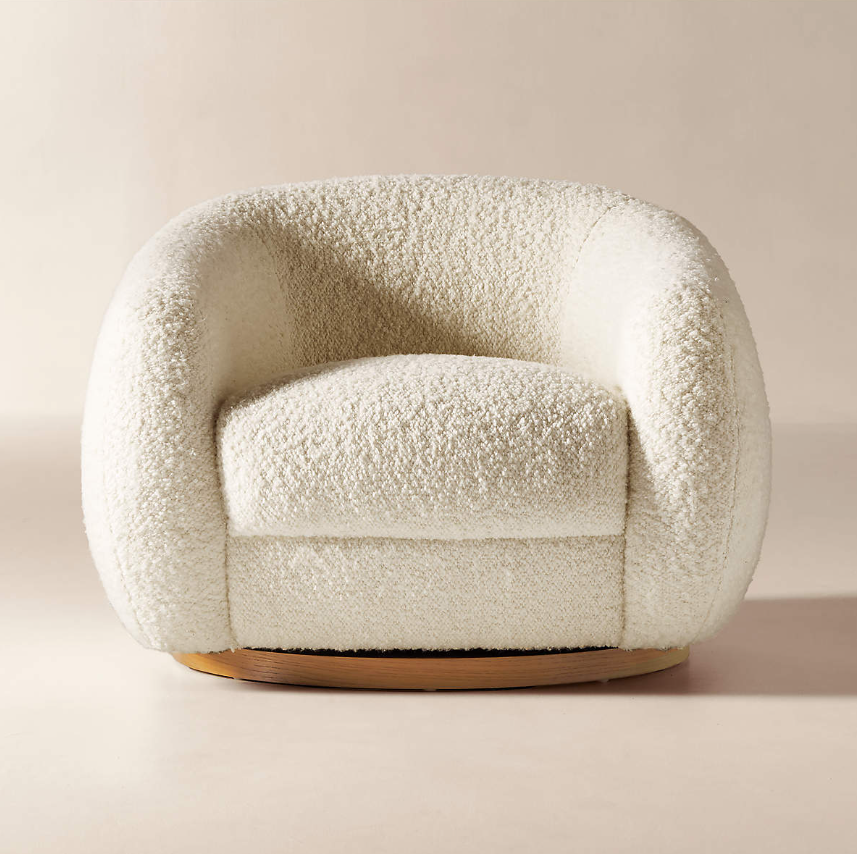Let’s talk about bouclé.
You’ve seen it everywhere—on TikTok, in every influencer’s home, wrapped around curved sofas that all look like oversized marshmallows. It’s the texture of the moment. The shorthand for “elevated.” The darling of design trends that prioritize the look of luxury over the longevity of anything.
But behind the nubby, cozy facade, bouclé has an ugly side—especially the kind you’re most likely to find at mainstream retailers.
The Basics: What Is Bouclé?
The word bouclé comes from the French for “curled” or “looped,” which describes the yarn’s texture. It creates a loopy, dimensional fabric that looks soft and cloud-like. And when it’s made from natural fibers—like wool or alpaca—it can be beautiful, durable, and biodegradable.
But that’s not what’s filling the shelves at Target, Wayfair, or West Elm.
Most of what’s marketed as bouclé today is made from synthetic fibers—polyester, acrylic, or nylon. It’s plastic masquerading as sophistication. And it comes at a high environmental cost.
The Problem with Synthetic Bouclé
1. It’s Petrochemical-Based Plastic
Polyester and acrylic are made from fossil fuels. Producing them releases significant CO₂ and other pollutants, including microplastics, which shed during use and washing.
2. It Doesn’t Break Down
Unlike wool, synthetic bouclé doesn’t biodegrade. Once that trendy chair is tossed (and it will be, once the next texture trend comes along), it sits in a landfill for decades—maybe centuries.
3. It’s Low-Durability, High-Turnover
Synthetic bouclé pills easily, stains quickly, and stretches out. It’s not made to last—it’s made to look good in a photo. And once it wears out, repair is nearly impossible.
4. It Greenwashes Like a Pro
Retailers love to pair synthetic bouclé with “organic shapes” and minimalist aesthetics to give the illusion of sustainability. But under the surface, it’s just fast fashion for furniture.
Wool Bouclé: Better, But Not Innocent
Wool bouclé is the traditional, natural version. It’s warm, breathable, and far more sustainable—especially if it’s ethically sourced and undyed. But even wool has a footprint. Industrial wool production can be water-intensive and linked to animal welfare concerns.
Still, when comparing the two, wool bouclé is the lesser evil by a mile. It’s natural, repairable, and compostable. If you must go bouclé, go wool—and go vintage or secondhand if you can.
So What’s the Alternative?
Skip the trend. Or subvert it.
Instead of buying into another disposable “moment,” design with what’s real. Thrifted upholstery. Vintage textures. Honest materials that age with dignity—linen, canvas, raw wool, old leather, salvaged wood.
Better yet, embrace variety. Not everything in your home has to match a mood board. Let it clash a little. Let it tell your story, not the story of some brand’s seasonal rollout.
Final Thought
Bouclé might look soft, but it’s hard on the planet. Especially when it’s synthetic, mass-produced, and designed to be replaced. So before you hit “add to cart” on that creamy curved armchair, ask yourself: is it love? Or is it just the algorithm?
Because trends pass. Landfills last.

Leave a Reply